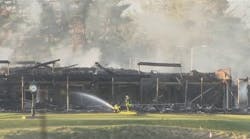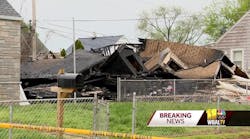In an earlier column, I stressed that you as the person in the right-front seat had to have a firm grasp on just which type of rig you were riding. This time, I am making the decision for you. I am choosing an engine company. This is not a tough assignment for me, as I spent six of my 13 years as a fire captain in Newark, NJ, commanding engine companies.
As an engine company officer, you must be able to bring all of the members of the team together for effective operations. The crew will include the person who drives the pumper, the people who carry the hose and squirt the water, and you as the leader of the pack.
Find the Water
More than 30 years ago, my first pump operations mentor in the Newark Fire Department gave me the primary recommendation for being an effective driver. He told me that my primary job is to find the water. He then made sure that I knew I had to get it to the people in my own company. Once they are supplied, you are then free to help as many other people as possible. The lesson stuck. All of my people knew that I considered water the key to success in engine company operations.
Let me follow up by stating you must have a source with enough water for your needs. In the larger urban and suburban areas, be sure to select the best hydrants for the task. This is done during your pre-incident planning. In rural areas, knowing ahead of time where drafting sites are can save a lot of time when time really counts.
My next tip to you is a follow-up to the first one: To get the job done, you need the proper-size supply hose to get the most from your source of water. With the advent of large-diameter hose, there is no excuse for failure to move enough water. The only failure is when you forget that it is your job to lay down the big line to move the necessary amount of water.
Simple common sense forms the basis for my next suggestion: Never shoot water at smoke. I have seen this basic concept violated frequently. There is an actual physical explanation for this recommendation.
Smoke Dangers
Shooting water at smoke causes the wet smoke to lose its heat-related upward lift and drop to the floor of the fire area. The poor visibility will make your job much more difficult. Search and rescue efforts will be slowed, and more important, the smoke may trap occupants attempting to exit the building under their own power. They may slow your operation, block your progress, and require one or more firefighters to remove them.
Smoke will also slow your progress as you move your attack lines in toward the fire. So while it may be a difficult, hot and dirty journey, push your lines in to the base of the fire before you open up with the water. It is best, whenever possible, to move in toward the seat of the fire and apply your water there.
Like any other rule, there is an exception to this. When your senses tell you that the potential exists for a flashover/rollover as you move in to attack the fire, you should shoot a quick burst of water above the fire; this can delay this possibility until proper ventilation is available. However, you must be very careful. If you are unable to quickly attack the fire, you may wish to pursue the attack from a safer location.
My next hint may be a bit controversial in today's safety-enhanced environment: I am suggesting that your greatest chance of success can come from making an aggressive interior attack on the seat of a fire, whenever possible. The problem with this rule is that people tend to apply it when it is too dangerous to enter the fire building. We tend to see too much of this kamikaze firefighting. You should know about this type of operation.
Think of the last time you saw a crew of firefighters going off to attack a barn fire or a warehouse blaze with a booster line. Let me offer you a real simple piece of advice: If you are rolling in on a blazing structure, and you have a gut feeling that attacking such a fire might be foolish or even suicidal, go with your gut.
Now is the time for a simple, common-sense rule for what size of hoseline to use in your attack. It is one I have used for decades and it is directly from the pages of my firefighting text, Firefighting Strategy and Tactics: The Eight-Step Method (Fire Protection Publications, 1998). Here goes:
Like beauty, big is in the eye of the beholder. What a firefighter in a small department might consider big could be quite different from what a firefighter in a large urban area would consider big. Your skills in this area will improve as you gain experience. You must first come to understand just how much fire a particular-size hoseline will extinguish. You will develop your confidence about what size hose to use under what situations through a process of study, drill, trial and elimination.
Let me once again head back to the world of common sense: When moving a line up a stairway, close the nozzle before you move up. How should you do this? Extinguish as much fire as you can reach from the base of the staircase, then shut the nozzle and move up the staircase.
As soon as you are set, spot the next area of fire and attack what you can reach. Moving any attack hoseline, regardless of size, is difficult. By shutting the nozzle, life will become a bit easier. If you doubt the wisdom of this hint, try it both ways. I have found this method to be much easier.
My next suggestion to you can save your troops from a great deal of harm: Never position yourself directly in front of a door to a burning room. If you are standing upright when the door is opened and it flashes or rolls over, you will be burned. Stay low and be ready. As a veteran of many decades in the fire business, I could tell you countless stories about being caught in a crowd while attempting to move into or out of a fire area. Therefore, this recommendation sometimes becomes a matter of self preservation. Do not crowd the attack crew.
Like any other element of a labor-intensive operation, the people on the hoseline nozzle need a certain amount of room to maneuver. They also need a way out if things go bad during the attack operation. In the old days, we used to call this the "Anvil Chorus." You could tell the size of the crowd blocking your way by listening for the sound of the clanging airpack tanks. It's a bit harder now with the lightweight cylinders. The clicking is not as loud as the clanging. Do not let your people become part of the problem.
The next recommendation is just another stab at good-old plain common sense: Never pass a fire. It may be necessary to have the attack team include personnel with forcible entry tools.
In this way, the coordinated effort can improve their chances of not passing a fire. They will be able to open up above, below and on the sides of the attack avenue. Many times, we have heard or read about people being trapped on an upper floor by a fire that was bypassed on a lower floor. It has been my experience that only in the rarest of circumstances has passing a fire ever been warranted. As you deploy your attack forces, you should handle fire as you encounter it.
Safety First
How much safer will it be if your crew on the first floor is handling that area of fire while your next hoseline crew moves by them to move up the staircase? In this way, you are able to operate in a progressive manner, with each line protecting the next. This allows you to deploy your forces in depth. And it is usually much safer.
I have come to regard my next recommendation as the one single rule that should never be violated: An engine company must work as a team. The members must combine their efforts for one purpose: the delivery of an effective fire attack stream. That stream can range all across the board. It might be a booster line being used to snuff out a garbage can. Or it can range up to a mighty master stream. Whatever the mission, the engine company must act as a team. Never forget this. Freelancing by engine company members can be fatal.
Very few fires have ever been extinguished without the use of some combination of pumper apparatus, water and hoselines being used by well-trained firefighters. If you are to succeed in the firefighting business, you need to know how to effectively deploy your engine company people.
Your job as the person in the right-front seat of an engine company is to perform your work in line with the above recommendations. You can do it your way or you can try it my way. Let me just suggest to you that my recommendations are based on many decades of trying and failing that were then followed by a session of picking myself off the deck and then trying again.
Let me further suggest that as the new person in the right-front seat, it may pay dividends for you to look at the words that are being offered to you by a seasoned veteran who has had his butt kicked by fire on far more than a single occasion. Good luck.
HARRY R. CARTER, Ph.D., a Firehouse® contributing editor, is a municipal fire protection consultant based in Adelphia, NJ, and a veteran of 47 years in the fire and emergency services. He is chairman of the Board of Commissioners in Howell Township Fire District 2 and retired from the Newark, NJ, Fire Department in 1999 as a battalion commander. Dr. Carter has also been a member of the Adelphia Fire Company since 1971, serving as chief in 1991. He is a life member and past president of the International Society of Fire Service Instructors and a life member of the National Fire Protection Association. Dr. Carter holds six degrees, with his terminal degree being a Ph.D. in organization and management, with a specialization in leadership, from Capella University in Minneapolis, MN, where he is an adjunct faculty member.





